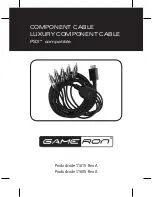
9
INSTALLING THE CABLE PG. 7
2
Methods for arranging the cable pattern for different parts of the roof are provided
on the following pages. The cable does not have to be installed in all of these
sections – only in the sections that have been susceptible to ice dams in the past
(see
Determining what areas need cable on page 5
). You may or may not need to
install cable along the roofline or near skylights or dormers. However, always install
cable in valleys that are a part of any problem area on your roof.
TIP:
Figure 2
shows a typical pattern along the roofline and in gutters and
downspouts. If you’ll be working directly on the roof during the installation,
you may want to mark the cable pattern with chalk before attaching the cable.
If working from a ladder, you will probably want to lay out the pattern as you
attach the cable with the clips. Making a drawing of your roof and planned
pattern on paper may be helpful.
2
PLAN THE PATTERN FOR YOUR ROOF
TYPICAL PATTERN ALONG ROOFLINE AND IN GUTTERS AND DOWNSPOUTS
The cable starting point must not be near any entrance areas, sidewalks, etc.
to avoid contact by persons or equipment (such as yard tools) that can move or
damage the cable. You may also want to avoid having the cable power cord routed
in front of windows or high-visibility areas of your home. For more information
on selecting a location for an electrical outlet, see
Electrical requirements on
page 6
.
If an electrical outlet already exists in an appropriate location near the eave, then
that defines your starting point. Otherwise, select an appropriate starting point and
have an electrical outlet installed.
1
CHOOSE A STARTING POINT










































